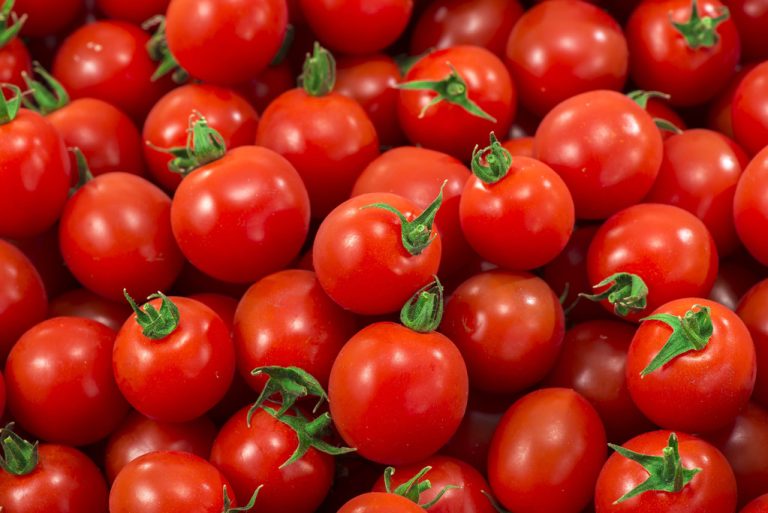Tomatoes are not only delicious, but also extremely healthy. We’ll show you what’s in them and what you should look out for when buying.
Tomatoes (also known as “paradeiser” in Austria) are omnipresent in our diet. That’s why we rarely think about how healthy they actually are. Because tomatoes are small all-round talents that support our skin and our heart and are even said to prevent some types of cancer.
Ingredients and effect: This makes tomatoes healthy
Tomatoes are 95 percent water and 4 percent carbohydrates. Most of these are simple sugars like glucose and fructose. Nevertheless, they are particularly low in calories with 18 kilocalories per 100 grams.
Among other things, tomatoes have the following vitamins:
vitamin C
potassium
Vitamin K1
Vitamin B9 (folic acid)
In addition to the healthy vitamins, tomatoes are also rich in the following substances:
Lycopene (a carotenoid)
Beta Carotene (Pro-Vitamin A)
Naringenin (flavonoid, bitter substance)
chlorogenic acid
These different carotenoids, flavonoids and acids are responsible for the special healthy effects of tomatoes. You can support your health in many ways:
Sun and UV protection: Carotenoids and flavonoids are already responsible in the plant for offering protection from the sun’s harmful radiation. But they can also develop this effect in humans through the right diet: Beta-carotene and lycopene in particular have been proven to protect your skin from UV radiation and sunburn.
Obesity: Tomatoes reduce the side effects of morbid obesity: According to a study in which various overweight patients were given tomato powder, various symptoms were drastically reduced: metabolic problems decreased, fat deposits in the organs were reduced and inflammation in the fatty tissue decreased.
Diabetes: The lycopenes in tomatoes were also shown to reduce insulin resistance and inflammation levels in mice tested. Both lycopene and chlorogenic acid reduce blood triglycerides, which can be responsible for the development of diabetes. They are dietary fats that are regularly converted into energy in healthy people. If the intake is too high or if there are metabolic disorders such as diabetes or obesity, they can become a problem.
Prevents cancer: According to an analysis of various studies, lycopene reduces the risk of prostate cancer in older male patients. This is thought to be due to its antioxidant abilities. Furthermore, the substance has a supporting effect in the therapy of lung cancer.
Heart Health: Lycopenes reduce bad LDL cholesterol in the blood while also reducing inflammation and oxidative stress, all of which are detrimental to your heart’s aging and performance. The tomato substance also protects the cell walls and prevents deposits in your arteries.
Healthy tomatoes and their ripening process
Tomatoes produce a hormone gas called ethylene during their natural ripening process. However, as food producers want to get fresh tomatoes into stores, the vegetables are harvested green and sprayed with ethylene en route. This allows them to ripen just before they are sold and end up in the supermarket bright red.
As the tomatoes do not have time for their natural ripening process, the development of the natural taste and aroma of the berries is suppressed. This is also the reason why cheap tomatoes often taste watery and “like nothing”.
That’s why you should always use seasonal and local tomatoes. These do not have to travel long distances, so they can mature naturally and develop their full aroma.
You should also keep this in mind: The ripening hormone ethylene is also responsible for the fact that other fruits and vegetables near the healthy tomatoes ripen faster. That’s why you should always keep them away from other sensitive foods unless you want to speed up their ripening process (like avocados, for example).
Tomato allergy and intolerance
If you suffer from a pollen allergy, you are more likely to also suffer from certain food intolerances. This can include various types of fruit and vegetables, but also animal products such as chicken or eggs. One vegetable that is particularly affected is the tomato. So if you often have colds in spring and summer, you may not tolerate tomatoes.
This is because some fruits and vegetables contain proteins similar to those found in grass pollen. Your immune system then tries to fight them in a similar way, which can result in typical allergy symptoms, so if you experience symptoms such as itchy mouth and throat, breakouts, stomach pain and digestive problems, you may want to get tested by a doctor beforehand you order the next pizza.
In addition to pollen, there is another, rather unexpected allergy associated with the healthy vegetable: If you are allergic to latex, you may have a tomato allergy or intolerance. In the case of the so-called “latex-fruit syndrome”, it is also the defense proteins in the various fruits and the natural natural rubber that are very similar and are similarly warded off by the body.

Tomatoes: origin and botanical classification
Tomatoes are prepared in many different ways around the world. We mainly use them in salads or make tomato sauce for spaghetti and pizza. The vegetable only found its way to us in the 16th century:
Around 1500, Christopher Columbus brought the tomato from South America to Europe. Their name goes back to their original name in the Aztec language “Nahuatl”: “tomatl”. Europeans only started to actually eat them towards the end of the 16th century – before that, the tomato was seen more as a poisonous ornamental plant. Only towards the end of the First World War did the Germans start eating tomatoes regularly. Today they are an integral part of the local cuisine.
Tomatoes grow annually on shrubs and belong to the nightshade family. They come in different shapes and varieties: from the small, round cherry tomatoes to the oblong, firm roma tomatoes to the large, juicy beefsteak tomatoes. Botanically, however, tomatoes (Solanum lycopersicum) are not vegetables at all, but berries. Nevertheless, they are traditionally used for culinary purposes like vegetables.

